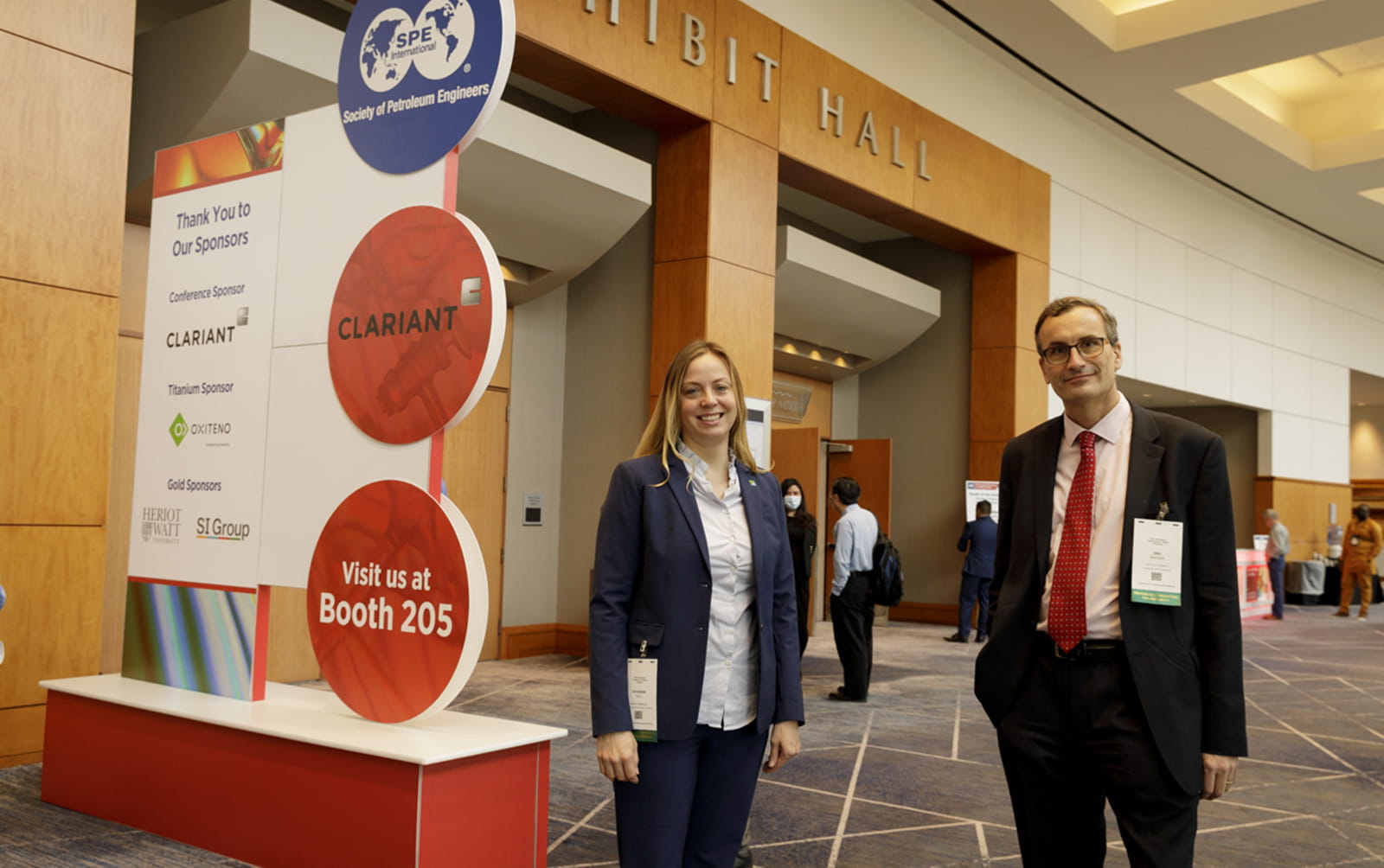SPE examines emerging chemical technologies

SPE International Conference on Oilfield Chemistry Program Committee Chairperson Eric Mackay and Vice Chairperson Katherine Hull oversaw a technical program highlighting the latest research and application of oilfield chemistry.
The Society of Petroleum Engineers (SPE) gathered in Houston in early December for its biennial International Conference on Oilfield Chemistry, examining emerging chemical technologies and field applications. Aramco researchers participated highlighting new advances, techniques, and novel additives for oilfield chemistry moving beyond the lab and into the field.
For decades chemistry has advanced hydrocarbon recovery through deployment in drilling, stimulation, completions, and production processes. The number and complexity of chemicals has increased, and now new and novel chemistries are playing an increased role in reducing the environmental impact of operations—even sequestering CO2 to lower the carbon footprint.
“The emerging role of chemistry in maximizing economic recovery in a sustainable manner is a key theme of the conference,” said Eric Mackay, Program Committee Chairperson and Energi Simulation Chair in CCUS and Reactive Flow Simulation, Heriot-Watt University.
“We are strategically aligning our innovation portfolio to improve operation efficiency while focusing on new technologies to reduce CO2 emissions,” said Ashraf Altahini, EXPEC ARC Manager.

Researchers from Aramco Americas presented at the SPE International Conference on Oilfield Chemistry. (left to right) Eric Mackay, Program Committee Chairperson, Heriot-Watt University joins Aramco Americas researchers Katherine Hull, Martin Poitzsch Mohammed Sayed, Elizabeth Contreras, and Ashok Santra kicking off day one of the conference.
Aramco Americas researcher Katherine Hull served as conference Vice Chairperson, leading two sessions addressing green stimulation technologies and enhanced oil recovery. Six Aramco papers over the two-day event highlighted breakthrough work in drilling fluids, polymers, and other production challenges.
Hull, a research science specialist on the Production Technology team at the Aramco Research Center-Houston, says research and development initiatives must align with sustainability.
Opening remarks from Martin Poitzsch, Reservoir Engineering Technology Leader, Aramco Research Center-Boston, offered an overview of energy transition issues, emphasizing the opportunities for oilfield chemists and engineers to introduce efficiencies and technologies in upstream operations. “Oilfield chemistry plays a critical and essential role to achieve our industry aspirations to reduce carbon emission,” said Poitzsch. He pointed to the catalysis of chemicals and enhanced CO2 sequestration through novel treatments as two examples.
Elizabeth Contreras, a member of the Drilling Technology Team, Aramco Research Center-Houston, focuses on work with specialized additives for cement with engineered polymers to sequester CO2 and enhance the lifespan of cement.
Contreras, who recently participated in an SPE LIVE webinar discussing methods for reduced carbon footprint in upstream operations, presented “CO2 Sequestration by Polyaramide Vesicles in Cementing” explaining, “the vesicles are embedded in cement to extract CO2. We also found that this imparted elasticity to the cement as a secondary benefit as well.”
Contreras hopes to see what kind of impact this technology will have in the future not only in the construction of oil wells, but also in infrastructures above ground. “In developing new chemistries and new materials, we are taking a broader view—application beyond the energy,” she said.
Addressing the elastic properties in oil well cements, Hasmukh Patel, Senior Lab Scientist, also based at Aramco's research center in Houston, explained frequent stresses deteriorate mechanical properties of oil and gas well cements leading to micro-cracks and fractures that can affect production and increase operation costs. His work using specialized polymers, triazine-based polymers, creates strong bonding between cement particles and additives to facilitate stress distribution through structural rearrangement in the cement sheath.
Two additional Aramco papers “Next Generation High Performance Invert Emulsion Drilling Fluids with Flat-Rheological Behavior” and “A Novel Epoxy Resin Composition as a Lost Circulation Material: Formulation, Lab Testing and Field Execution,” highlighted drilling fluids advancements.
Ashok Santra, Research Science Consultant, based in Houston, told attendees that the advancements they have made with drilling fluids are providing fluid flow behavior not so sensitive, or “flat like” to temperature changes unlike other commercial systems. He noted that four Aramco proprietary novel additives were invented for this system.
The hybrid conference format brought attendees to Texas and offered others the chance to view a live broadcast with recorded technical sessions. More than 300 attended in person with an exhibition area featuring specialty chemical companies and other oilfield chemistry providers. The next conference is slated to be held in Houston in 2023.
Our global research network has facilities located in targeted innovation hubs in the United States, Europe, and Asia addressing global energy challenges.



